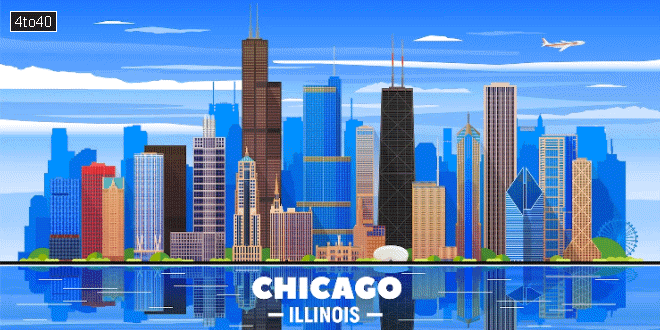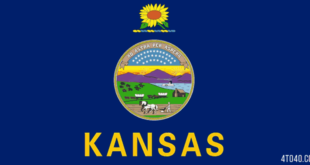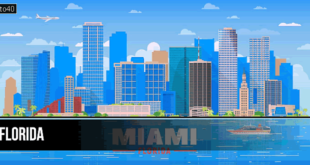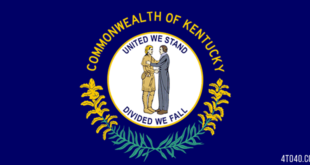Illinois, is a leading agricultural, manufacturing, and urban state of the north central region of the United States. It is bordered by Wisconsin on the north, Lake Michigan on the northeast, Indiana on the east and southeast, and Kentucky on the south. The Ohio River follows its southern border, and the Mississippi in the west and southwest of the state lies along its borders with Iowa and Missouri.
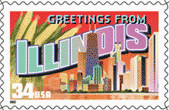 Inhabited thousands of years ago by Indians, Illinois was explored by the French Jesuit missionary Jacques MARQUETTE and frontiersman Louis JOLLIET, who reached the area on June 20, 1673. The French changed the Indian name for the area, Illiniwek, meaning “the men,” to Illinois. Illinois became a state on Dec. 3, 1818. Although the 25th largest state in size, its population is ranked sixth largest of all states. The state’s population increased by only a few thousand between 1980 and 1990. SPRINGFIELD became the capital in 1837. Since 1850, Illinois has been a major state in all economic sectors. Now it faces the problems of increasing urbanization and interregional economic competition.
Inhabited thousands of years ago by Indians, Illinois was explored by the French Jesuit missionary Jacques MARQUETTE and frontiersman Louis JOLLIET, who reached the area on June 20, 1673. The French changed the Indian name for the area, Illiniwek, meaning “the men,” to Illinois. Illinois became a state on Dec. 3, 1818. Although the 25th largest state in size, its population is ranked sixth largest of all states. The state’s population increased by only a few thousand between 1980 and 1990. SPRINGFIELD became the capital in 1837. Since 1850, Illinois has been a major state in all economic sectors. Now it faces the problems of increasing urbanization and interregional economic competition.
https://www.youtube.com/watch?v=NpIRnYqUXmE
Land & Resources
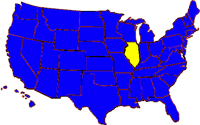 Illinois is composed of about 60% prairie, 30% hills with prairie, and 10% hills. The prairies cover central, northeastern, eastern, and south central Illinois; hills with prairie are found in northwestern, western, and southern Illinois; hills characterize the DRIFTLESS AREA of the extreme northwest and the Shawnee Hills in the south. Geologically most of Illinois consists of ancient Precambrian granite overlain by sedimentary rocks of the Pennsylvanian and Mississippian periods (280-345 million years ago). These formations underlie 80% of the state in a bowl-shaped structure extending from the Shawnee Hills in the south to the Illinois River in the north-central. The northern fifth of the state contains bedrock from the Silurian, Ordovician, and Cambrian periods (more than 400 million years ago). After the deposition of bedrock, four glaciers covered 90% of Illinois from 1.2 million to 13,000 years ago. Their effects are seen in glacial deposits, wind-blown soil (loess), and morainal ridges.
Illinois is composed of about 60% prairie, 30% hills with prairie, and 10% hills. The prairies cover central, northeastern, eastern, and south central Illinois; hills with prairie are found in northwestern, western, and southern Illinois; hills characterize the DRIFTLESS AREA of the extreme northwest and the Shawnee Hills in the south. Geologically most of Illinois consists of ancient Precambrian granite overlain by sedimentary rocks of the Pennsylvanian and Mississippian periods (280-345 million years ago). These formations underlie 80% of the state in a bowl-shaped structure extending from the Shawnee Hills in the south to the Illinois River in the north-central. The northern fifth of the state contains bedrock from the Silurian, Ordovician, and Cambrian periods (more than 400 million years ago). After the deposition of bedrock, four glaciers covered 90% of Illinois from 1.2 million to 13,000 years ago. Their effects are seen in glacial deposits, wind-blown soil (loess), and morainal ridges.
Climate
The climate of Illinois has distinct north-south fluctuations over the 620-km (385-mi) length of the state. The length, lack of significant elevation, continental location, and dominant westerly frontal pattern influence the climate. Average annual precipitation ranges from 1,130 mm (45 in) in southern Illinois to 880 mm (35 in) in northern Illinois. Heaviest monthly amounts fall during late spring and early summer. Long-term average temperatures also vary from north to south. Winter average temperatures are minus 4 deg C (25 deg F) in the north and 2 deg C (36 deg F) in the south. Summer averages are 24 deg C (75 deg F) in the north and 26 deg C (79 deg F) in the south. Atmospheric storms move across the state from west to east, with convective thunderstorms during spring and summer. Cold and warm-air frontal systems cause most atmospheric storms in the fall and winter.
Vegetation
The original forest vegetation was initially burned off by early humans, leaving tall prairie grasses, averaging 1.5 to 2 m (5 to 6 ft) in height. Mixed deciduous forests (oak, hickory, maple, beech, sweet gum, elm, ash, cedar, pine, tamarack, fir) covered the southern third of the state and most river valleys. The mixed forest-grass vegetation of the 18th century was cleared quickly by farming. Wildlife includes large numbers of white-tailed deer, rabbit, squirrel, red fox, quail, and pheasant, along with several waterfowl species that fly through seasonally.
Resources
Extracted minerals include petroleum, natural gas, clay, silica, fluorspar, lead, zinc, and limestone. Illinois is the fourth to sixth largest producer of bituminous coal in the United States, depending on annual fluctuations. The coalfield, underlying 70% of the state, has yielded several billion tons since first mined in 1882. Annual production averages about 60 million tons. Surface water is used for agriculture, industry, city water supplies, and electrical and nuclear power plants.
Historical Sites
The heritage of Abraham LINCOLN in Illinois is preserved at Lincoln’s Monument and Tomb and the Lincoln Home National Historic Site in Springfield. New Salem State Historic Site and the Vandalia Statehouse State Historic Site commemorate the beginnings of territorial settlement. CAHOKIA MOUNDS and Dickson Mounds are important relics of the state’s Indian past. Other historic sites include the Stephen A. DOUGLAS Monument in Winchester, Kaskaskia Island in the Mississippi River, and the Ulysses S. GRANT home in Galena.
Tourism
Tourists spend more than $6 billion annually–about 7% of the gross state product–in state parks and other recreational facilities. Outdoor recreational facilities are plentiful, and many are accessible through the year. Shawnee National Forest, composed of two separate areas, is located in southern Illinois. Major sports stadiums located in Chicago include Soldier Field, Chicago Stadium, Wrigley Field, and Comiskey Park.
Illinois State: History
Thousands of years before the French reached Illinois, Paleo-Indians, a nomadic people, and their descendants, archaic Indians, had explored Illinois. The culture of these hunters, dated before 5000 BC, can be studied at the Modock Rock Shelter in Randolph County. Woodland Indians were their descendants. By AD 900, Middle Mississippi Indians, who succeeded the Woodland Indians, built large earthen mounds and developed complex urban areas. These cities disappeared possibly because of overpopulation, disease, and exhaustion of resources. The descendants of the Mississippians were the Illiniwek tribes of the 17th, 18th, and 19th centuries. After years of losing land and wars to other Indian groups and European colonists, the Illiniweks were moved to a Kansas reservation.
The French controlled areas along the Mississippi River valley in the American Bottoms between Cahokia and Kaskaskia. Their occupation, from about 1675 to 1763, left few lasting marks, as did the ineffective British rule. European control was ended by the U.S. militia of Gen. George Rogers CLARK in 1778, whereupon Virginia claimed Illinois as within its territory.
The Northwest Ordinance of 1787 charted this region and organized counties, and in 1809 the Territory of Illinois was created. During the early years of settlement by fur trappers, southern Illinois was the focus of migration to the area, especially along the Mississippi River valley and the Wabash and Ohio rivers. Granting of statehood in 1818 was controversial. The population numbered less than the required 60,000. Moreover, in order to include the Chicago port area, territorial representatives induced the U.S. Congress to draw the Illinois border 51 miles to the north of the original boundary as delimited by the Northwest Ordinance. Vandalia, along the Kaskaskia River, was chosen capital of the new state by its legislature, a position it held for 20 years. After strong pressure from Abraham Lincoln, the capital was moved to Springfield by an 1837 legislative vote.
Early statehood problems engulfed Illinois. In the 1830s the state was near bankruptcy because of government financing of canals and railroad construction. The BLACK HAWK WAR in 1832 was fought by the Indians and newly arrived settlers over possession of Illinois land. Disease was rampant and death common. Adherents to Mormonism, who had migrated from Missouri in 1839, were charged with many illegalities and finally driven from the state after their leader, Joseph SMITH, had been murdered in 1844.
The Civil War caused mixed loyalties among Illinoisans, many of whom were first- or second-generation Southerners. However, many took pride in the fact that the Union was led by a native son, Lincoln, and the state provided 250,000 soldiers to the Union army. It also was the weapons manufacturer, supplier of iron products, and major grain and meat supplier for the North.
By 1880, Illinois had become the fourth largest state in population. It was a leader in grain production and manufacturing. The huge migration of Europeans to Illinois provided labor to mine coal, run steel mills, and enhance the economy and culture of the state. By 1920, Illinois was counted among the foremost states in nearly every significant growth variable–coal mining, industry, farming, urbanization, transportation, and wholesaling. Its leadership was achieved despite the economic slumps of the 1880s, 1890s, and early 1900s; the labor disputes in coal mining and railroading; the Chicago fire of 1871; and the problems caused by organized crime. World War I and World War II boosted the economy of Illinois, which soon had five ordnance depots and numerous military training camps.
The post-World War II era was a time of industrial modification to the postwar production of consumer goods. Even though meat-packing companies began to move away from Chicago and East Saint Louis, in part because of obsolete physical plants, Illinois farms were being mechanized and upgraded for increased output. The use of hybrid seed, chemical fertilizer, herbicides, and insecticides resulted in larger crop yields. Post-World War II Illinois experienced rapid population growth. The rising number of school-age children brought about public school reform, rural school consolidations, and huge suburban educational plants. Migration streams of blacks from the South, Hispanics from Mexico and Puerto Rico, and whites from Appalachia reshaped neighborhoods in Chicago, its suburbs, and other large Illinois cities.
The future of Illinois appears to be one of continued reduction in the number of small farm owners and consolidation into huge corporate farm operations. The out-migration of whites and in-migration of blacks and Hispanics to Chicago will result in the state’s largest city being dominated in number, vote, and control by poorer minorities while surrounded by more affluent white-dominated suburbs. The extensive railroad system is being trimmed because of financial losses, necessitating a growing dependence on interstate trucking systems. Illinois’s growth since the days of Lincoln has ensured its position as a major “heartland” state of the nation.
Illinois State: Land
- Area: 150,007 sq km (57,918 sq mi); rank: 24th.
- Capital: Springfield (1990 pop., 105,227).
- Largest city: Chicago (1990 pop., 2,783,726).
- Counties: 102.
- Elevations: highest–376 m (1,235 ft), at Charles Mound; lowest–85 m (279 ft), at the Mississippi River.
 Kids Portal For Parents India Kids Network
Kids Portal For Parents India Kids Network
